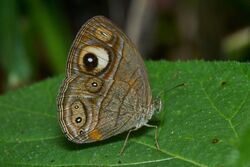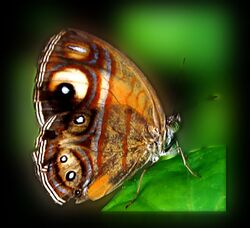Biology:Mycalesis patnia
| Glad-eye bushbrown | |
|---|---|

| |
| Scientific classification | |
| Domain: | Eukaryota |
| Kingdom: | Animalia |
| Phylum: | Arthropoda |
| Class: | Insecta |
| Order: | Lepidoptera |
| Family: | Nymphalidae |
| Genus: | Mycalesis |
| Species: | M. patnia
|
| Binomial name | |
| Mycalesis patnia | |
| Synonyms | |
|
Mycalesis junonia Butler, 1868 | |
Mycalesis patnia, the glad-eye bushbrown,[1][2] is a satyrid butterfly found in southern India and Sri Lanka.[1][2]
Description
Upperside: The male has a dark umber-brown ground colour slightly suffused with ochraceous. Forewings and hindwings with bright ochraceous-yellow, slender sub-terminal and terminal lines; cilia pale brown. Forewing with a large median and a much smaller subapical white-centred black ocellus, each with an orange-yellow iris, the upper portion of the iris round the median ocellus very broad, the lower incomplete and a more or less triangular orange-yellow discal patch. Hindwing uniform, with two very small fulvous-ringed black ocelli.[3]
Underside of male deep ochraceous yellow, subterminal and terminal line as on the upperside; forewing and hindwing crossed near base by a darker ochraceous-yellow line, followed by a silvery discal band, beyond which there are two ocelli as on the upperside, but each encircled also by an outer silvery ring; and on the hindwing a curved series of seven similar ocelli having a silvery band bordering them on both sides, the third and fourth ocelli from tornus together and the apical ocellus by itself placed on a brighter ochraceous patch encircled with black. Antennae, head, thorax and abdomen brown, somewhat ochraceous beneath. Sex-mark is present in one morph.[3]
The female is similar to the male but more strongly suffused with ochraceous on the upperside; the orange-yellow patch on the forewing larger, spreading to the base of the wing and no ocelli on the hindwing. Underside as in the male, but of a brighter ochraceous yellow; basal area of both forewing and hindwing crossed by two darker yellow bands, and the discoidal cell of the forewing with an interior loop of the same colour.[3][4]
The southern Indian race M. p. junonia[5] is identical to the nominate race from Sri Lanka but on the upperside is a duller brown; the median ocellus on the forewing encircled with pure white; no discal patch, or merely faint traces of one. Underside: markings similar to those in M. p. patnia, but altogether of a duller and browner shade, without any general ochraceous tint, a large bright ochraceous spot posteriorly on the hindwing in the male. The median ocellus on the forewing broadly encircled with white. Male sex-marks are seen in one morph.[3]
It has a wingspan of 42–54 mm.
- Life cycle
References
- ↑ 1.0 1.1 R.K., Varshney; Smetacek, Peter (2015). A Synoptic Catalogue of the Butterflies of India. New Delhi: Butterfly Research Centre, Bhimtal & Indinov Publishing, New Delhi. pp. 175. doi:10.13140/RG.2.1.3966.2164. ISBN 978-81-929826-4-9. https://www.researchgate.net/publication/287980260.
- ↑ 2.0 2.1 Savela, Markku. "Mycalesis Hübner, 1818 - Bushbrowns". http://ftp.funet.fi/index/Tree_of_life/insecta/lepidoptera/ditrysia/papilionoidea/nymphalidae/satyrinae/mycalesis/.
- ↑ 3.0 3.1 3.2 3.3
 This article incorporates text from a publication now in the public domain: Bingham, Charles Thomas (1905). Fauna of British India. Butterflies Vol. 1. pp. 66–67. https://archive.org/stream/butterfliesvolii00bing#page/66/mode/2up/.
This article incorporates text from a publication now in the public domain: Bingham, Charles Thomas (1905). Fauna of British India. Butterflies Vol. 1. pp. 66–67. https://archive.org/stream/butterfliesvolii00bing#page/66/mode/2up/.
- ↑ Moore, Frederic (1890). Lepidoptera Indica. Vol. I. London: Lovell Reeve and Co.. pp. 215–217. https://www.biodiversitylibrary.org/item/103554#page/233/mode/1up.
- ↑ Butler, Arthur Gardiner (1868). Catalogue of Diurnal Lepidoptera of the Family Satyridæ in the Collection of the British Museum. British Museum (Natural History). Dept. of Zoology. pp. 146. https://www.biodiversitylibrary.org/item/36601#page/156/mode/1up.
Wikidata ☰ Q3270907 entry
 |















